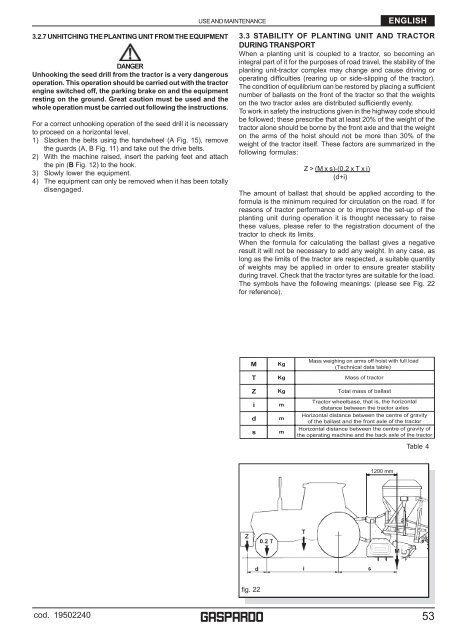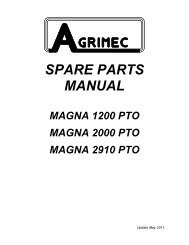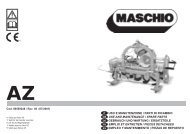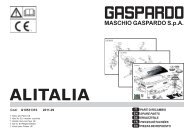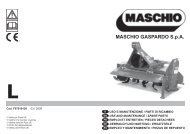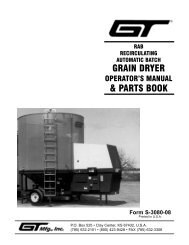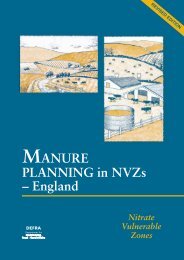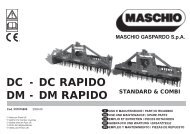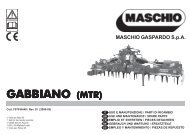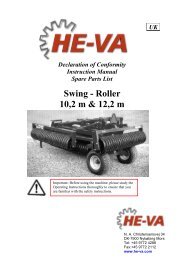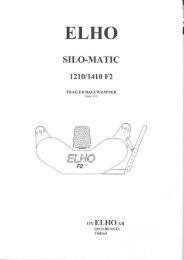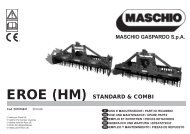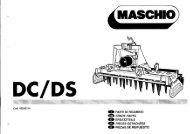GASPARDO Seminatrici SpA - Opico
GASPARDO Seminatrici SpA - Opico
GASPARDO Seminatrici SpA - Opico
Create successful ePaper yourself
Turn your PDF publications into a flip-book with our unique Google optimized e-Paper software.
3.2.7 UNHITCHING THE PLANTING UNIT FROM THE EQUIPMENT<br />
DANGER<br />
Unhooking the seed drill from the tractor is a very dangerous<br />
operation. This operation should be carried out with the tractor<br />
engine switched off, the parking brake on and the equipment<br />
resting on the ground. Great caution must be used and the<br />
whole operation must be carried out following the instructions.<br />
For a correct unhooking operation of the seed drill it is necessary<br />
to proceed on a horizontal level.<br />
1) Slacken the belts using the handwheel (A Fig. 15), remove<br />
the guards (A, B Fig. 11) and take out the drive belts.<br />
2) With the machine raised, insert the parking feet and attach<br />
the pin (B Fig. 12) to the hook.<br />
3) Slowly lower the equipment.<br />
4) The equipment can only be removed when it has been totally<br />
disengaged.<br />
USE AND MAINTENANCE<br />
cod. 19502240 g<br />
M Kg<br />
ENGLISH<br />
3.3 STABILITY OF PLANTING UNIT AND TRACTOR<br />
DURING TRANSPORT<br />
When a planting unit is coupled to a tractor, so becoming an<br />
integral part of it for the purposes of road travel, the stability of the<br />
planting unit-tractor complex may change and cause driving or<br />
operating difficulties (rearing up or side-slipping of the tractor).<br />
The condition of equilibrium can be restored by placing a sufficient<br />
number of ballasts on the front of the tractor so that the weights<br />
on the two tractor axles are distributed sufficiently evenly.<br />
To work in safety the instructions given in the highway code should<br />
be followed; these prescribe that at least 20% of the weight of the<br />
tractor alone should be borne by the front axle and that the weight<br />
on the arms of the hoist should not be more than 30% of the<br />
weight of the tractor itself. These factors are summarized in the<br />
following formulas:<br />
fig. 22<br />
Mass weighing on arms off hoist with full load<br />
(Technical data table)<br />
T Kg Mass of tractor<br />
Z Kg Total mass of ballast<br />
i m<br />
d m<br />
s m<br />
Z > (M x s)-(0.2 x T x i)<br />
(d+i)<br />
The amount of ballast that should be applied according to the<br />
formula is the minimum required for circulation on the road. If for<br />
reasons of tractor performance or to improve the set-up of the<br />
planting unit during operation it is thought necessary to raise<br />
these values, please refer to the registration document of the<br />
tractor to check its limits.<br />
When the formula for calculating the ballast gives a negative<br />
result it will not be necessary to add any weight. In any case, as<br />
long as the limits of the tractor are respected, a suitable quantity<br />
of weights may be applied in order to ensure greater stability<br />
during travel. Check that the tractor tyres are suitable for the load.<br />
The symbols have the following meanings: (please see Fig. 22<br />
for reference).<br />
Tractor wheelbase, that is, the horizontal<br />
distance between the tractor axles<br />
Horizontal distance between the centre of gravity<br />
of the ballast and the front axle of the tractor<br />
Horizontal distance between the centre of gravity of<br />
the operating machine and the back axle of the tractor<br />
1200 mm<br />
Table 4<br />
53


